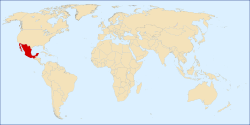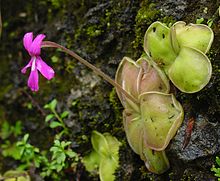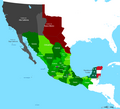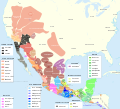Portal:Mexico
|
The Temple of Warriors at Chichen Itza, Mexico
¡Bienvenido! Welcome to the Mexico portal
Mexico, officially the United Mexican States, is a country in the southern portion of North America. It covers 1,972,550 km2 (761,610 sq mi), making it the world's 13th-largest country by area; with a population of almost 130 million, it is the 10th-most-populous country and the most populous Spanish-speaking country. Mexico is organized as a federal constitutional republic comprising 31 states and Mexico City, its capital. It shares land borders with the United States to the north, with Guatemala and Belize to the southeast; as well as maritime borders with the Pacific Ocean to the west, the Caribbean Sea to the southeast, and the Gulf of Mexico to the east.
This is a Featured article, which represents some of the best content on English Wikipedia.
Pinguicula moranensis /pɪŋˈɡwɪkjʊlə ˌmɒrəˈnɛnsɪs/ is a perennial rosette-forming insectivorous herb in the flowering plant family Lentibulariaceae. It is native to El Salvador, Guatemala, Honduras and Mexico. A species of butterwort, it forms summer rosettes of flat, succulent leaves up to 10 centimeters (4 in) long, which are covered in mucilaginous (sticky) glands that attract, trap, and digest arthropod prey. Nutrients derived from the prey are used to supplement the nutrient-poor substrate that the plant grows in. In the winter the plant forms a non-carnivorous rosette of small, fleshy leaves that conserves energy while food and moisture supplies are low. Single pink, purple, or violet flowers appear twice a year on upright stalks up to 25 centimeters long. The species was first collected by Humboldt and Bonpland on the outskirts of Mina de Morán in the Sierra de Pachuca of the modern-day Mexican state of Hidalgo on their Latin American expedition of 1799–1804. Based on these collections, Carl Sigismund Kunth described this species in Nova Genera et Species Plantarum in 1817. The extremely variable species has been redefined at least twice since, while several new species have been segregated from it based on various geographical or morphological distinctions, although the legitimacy of some of these is still debated. P. moranensis remains the most common and most widely distributed member of the Section Orcheosanthus. It has long been cultivated for its carnivorous nature and attractive flowers, and is one of the most common butterworts in cultivation. (Full article...)Selected article -Tequila (/təˈkiːlə/; Spanish: [teˈkila] ⓘ) is a distilled beverage made from the blue agave plant, primarily in the area surrounding the city of Tequila 65 km (40 mi) northwest of Guadalajara, and in the Jaliscan Highlands (Los Altos de Jalisco) of the central western Mexican state of Jalisco. The red volcanic soils in the region of Tequila are well suited for growing the blue agave, and more than 300 million plants are harvested there each year. Agave grows differently depending on the region. Blue agaves grown in the highlands Los Altos region are larger and sweeter in aroma and taste. Agaves harvested in the valley region have a more herbaceous fragrance and flavor. Due to its historical and cultural importance, the region near Tequila was declared a UNESCO World Heritage Site in 2006, the Agave Landscape and Ancient Industrial Facilities of Tequila. (Full article...)Selected pictureThis is a Good article, an article that meets a core set of high editorial standards.
Mis Romances (English: My Romances) is the fourteenth studio album of Mexican singer Luis Miguel, released on 20 November 2001 by Warner Music Latina. It is the fourth album in the Romance series wherein Luis Miguel covers bolero standards from Latin America and includes two original compositions. Produced by Luis Miguel, the album was recorded at the Record Plant in Los Angeles, California with the participation of the Royal Philharmonic Orchestra at the Abbey Road Studios in London, England. The recording was promoted by three singles: "Amor, Amor, Amor", "Cómo Duele", and "Al Que Me Siga". It was further promoted by a tour in 2002 that had Luis Miguel performing in the United States, Latin America, and Spain. It was the highest-grossing tour of the year by a Latin artist in the U.S. Mis Romances was neither a critical nor a commercial success. It was met with unfavorable reviews from critics who felt the record was too similar to its predecessors and lambasted Luis Miguel for not evolving his artistic style. Commercially, it peaked at number two on Billboard's Top Latin Albums and was the second bestselling Latin album of 2002 in the United States. Additionally, it reached number one in Argentina and was the bestselling record of the year in Mexico. Within nine days of its release. Mis Romances sold over 1.5 million copies, but failed to meet the record label's expectations. The album also won the Billboard Latin Music Award for "Latin Pop Album of the Year by a Male Artist" and "Album of the Year" at the 2002 Premio de la Gente. (Full article...)Selected biography -Miguel de la Madrid Hurtado (Spanish pronunciation: [miˈɣel de la maˈðɾið uɾˈtaðo]; 12 December 1934 – 1 April 2012) was a Mexican politician affiliated with the Institutional Revolutionary Party (PRI) who served as the 59th president of Mexico from 1982 to 1988. Inheriting a severe economic and financial crisis from his predecessor José López Portillo as a result of the international drop in oil prices and a crippling external debt on which Mexico had defaulted months before he took office, De la Madrid introduced sweeping neoliberal policies to overcome the crisis, beginning an era of market-oriented presidents in Mexico, along with austerity measures involving deep cuts in public spending. In spite of these reforms, De la Madrid's administration continued to be plagued by negative economic growth and inflation for the rest of his term, while the social effects of the austerity measures were particularly harsh on the lower and middle classes, with real wages falling to half of what they were in 1978 and with a sharp rise in unemployment and in the informal economy by the end of his term. (Full article...)
In the news
Selected fare or cuisine -
General imagesThe following are images from various Mexico-related articles on Wikipedia.
CategoriesTopicsRelated portalsWikiProjectYou are invited to participate in WikiProject Mexico, a WikiProject dedicated to developing and improving articles about Mexico. Associated WikimediaMore portals | ||||||||||


























































































